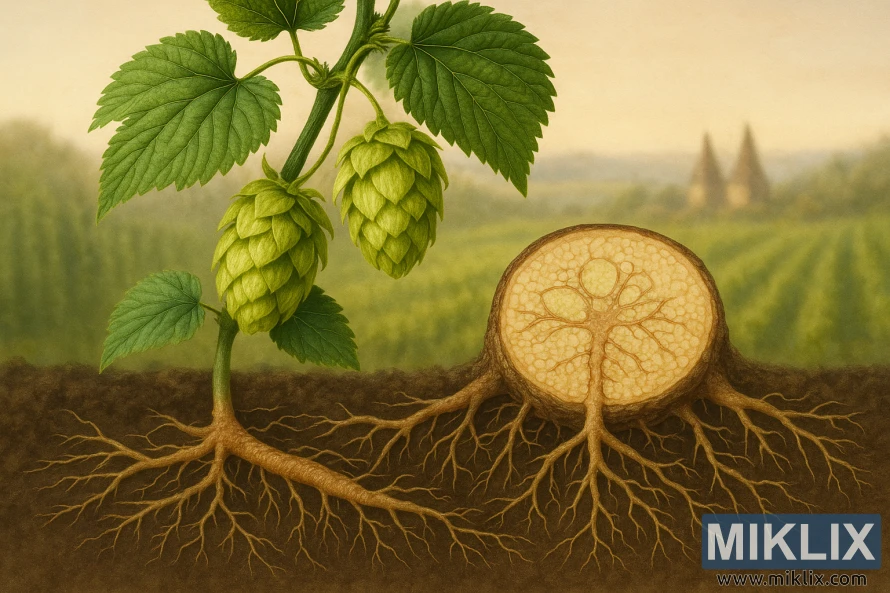Image: Genetic Lineage of the Merkur Hop: A Botanical Cross-Section
Published: November 19, 2025 at 12:31:38 AM UTC
A high-resolution artistic visualization of the Merkur hop variety, showing its lush bines, cones, and intricate rhizome system beneath the soil, symbolizing the plant’s robust growth and genetic heritage.
This high-resolution image presents a strikingly detailed visualization of the genetic and botanical essence of the Merkur hop variety, one of the distinguished cultivars prized in the world of brewing. The composition is both scientific and artistic, combining meticulous botanical detail with warm, natural atmosphere to capture the plant’s life cycle and its genetic vitality.
In the foreground, a vigorous hop bine rises gracefully from the soil. Its lush, serrated leaves spread outward in a vibrant display of deep and medium greens, their veins finely etched with naturalistic precision. Hanging from the bine are several hop cones—some compact and tightly scaled, others beginning to open as they mature. The cones range in hue from a bright, tender green to a soft yellow-green, suggesting different stages of development. Their papery lupulin glands are faintly visible beneath the bracts, hinting at the essential oils and aromatic compounds that define the Merkur’s balanced bitterness and herbal-citrus aroma.
Beneath the surface lies the true heart of the composition: a magnified cross-section of the hop’s subterranean rhizome system. The central rhizome, shown in a precise cutaway view, reveals its intricate internal structure—a honeycomb-like arrangement of vascular tissues and fibrous networks that convey water, nutrients, and genetic information throughout the plant. Radiating from this cross-section is an elaborate web of roots and lateral rhizomes, rendered in shades of amber and ochre that contrast warmly with the surrounding dark-brown earth. These root structures interlace with each other in a manner that evokes both natural resilience and evolutionary sophistication, symbolizing the deep genetic lineage that defines the Merkur hop.
The middle ground provides a sense of transition between scientific observation and agricultural context. The soil layer, rich and textured, gradually softens into the background, where a pastoral landscape unfolds. Rows of hop fields stretch into the distance, their trellised bines forming rhythmic, vertical patterns beneath a hazy sky. The background is purposefully blurred to create depth and atmospheric softness, evoking an impressionistic quality that contrasts beautifully with the sharp clarity of the foreground.
In the far distance, two distinct hop kilns (or oast houses) rise from the landscape, their conical roofs barely visible through the golden haze. These traditional structures serve as a subtle nod to the agricultural heritage of hop cultivation and the artisanal processes that follow harvest—drying, curing, and ultimately, brewing.
The lighting of the composition plays a vital role in unifying these elements. A soft, diffused sunlight bathes the entire scene in warm tones of gold, beige, and olive, enhancing the organic realism of the plant while imparting an almost sacred aura to the agricultural setting. This interplay of light and shadow adds dimensionality to the textures—the velvety leaves, the fibrous rhizomes, and the crumbly soil—all of which contribute to the image’s lifelike authenticity.
Symbolically, the image conveys more than botanical accuracy; it evokes the concept of genetic heritage, evolution, and agricultural craftsmanship. The Merkur hop, known for its disease resistance, vigorous growth, and balanced flavor profile, becomes here a visual metaphor for resilience, innovation, and the continuity of plant breeding traditions. Every element—the living bine above ground, the interconnected root network below, and the golden fields beyond—converges to illustrate the genetic and ecological integrity of this remarkable hop variety.
Overall, the image stands as both an educational and aesthetic masterpiece: a portrait of life beneath and above the soil, celebrating the complexity and beauty of one of brewing’s most essential plants.
The image is related to: Hops in Beer Brewing: Merkur

